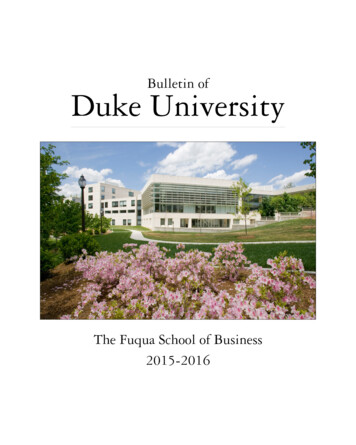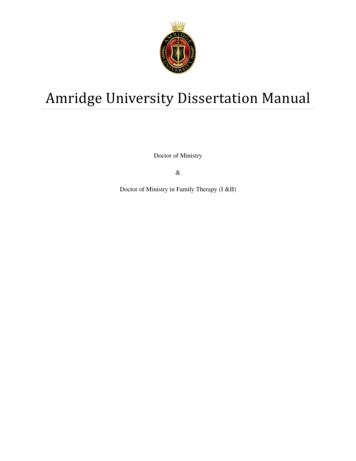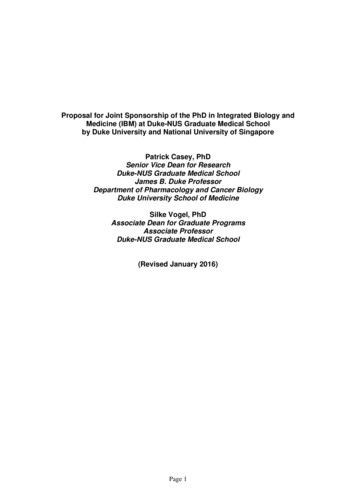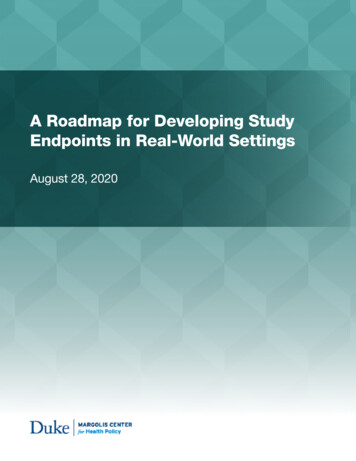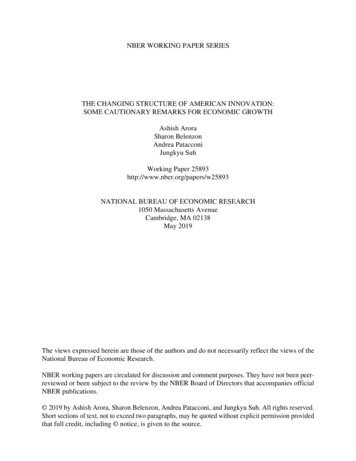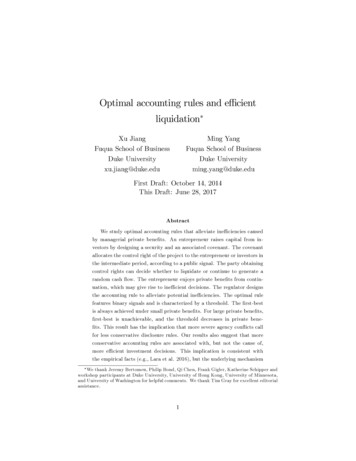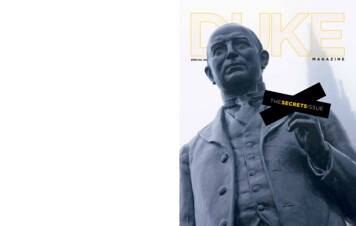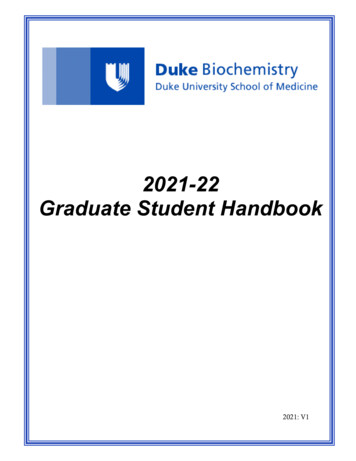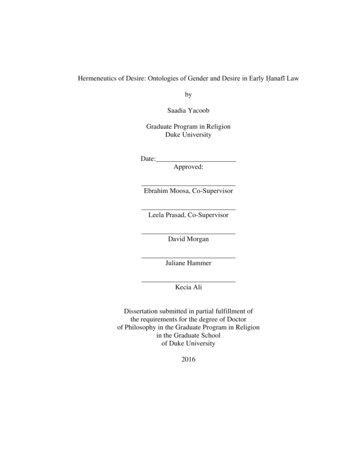
Transcription
Hermeneutics of Desire: Ontologies of Gender and Desire in Early Ḥanafī LawbySaadia YacoobGraduate Program in ReligionDuke UniversityDate:Approved:Ebrahim Moosa, Co-SupervisorLeela Prasad, Co-SupervisorDavid MorganJuliane HammerKecia AliDissertation submitted in partial fulfillment ofthe requirements for the degree of Doctorof Philosophy in the Graduate Program in Religionin the Graduate Schoolof Duke University2016
ABSTRACTHermeneutics of Desire: Ontologies of gender and desire in early Ḥanafī lawbySaadia YacoobGraduate Program in ReligionDuke UniversityDate:Approved:Leela Prasad, Co-SupervisorEbrahim Moosa, Co-SupervisorDavid MorganJuliane HammerKecia AliAn abstract of a dissertation submitted in partialfulfillment of the requirements for the degreeof Doctor of Philosophy in the Graduate Program in Religionin the Graduate School ofDuke University2016
Copyright bySaadia Yacoob2016
AbstractThis dissertation examines the construction of gendered legal subjects in theinfluential legal works of the eleventh century Ḥanafī jurist, Muḥammad ibn Aḥmad alSarakhsī (d. 483 A.H./1090 C.E.). In particular, I explore how gendered subjects areimagined in legal matters pertaining to sexual desire. Through a close reading of severallegal cases, I argue that gendered subjects in his legal work al-Mabsūṭ are constructedthrough an ontological framework that conceptualizes men as active and desiring andwomen as passive and desirable. This binary construal of gendered nature serves as ahermeneutical given in al-Sarakhsī’s legal argumentation and is produced through aphallocentric epistemology. Al-Sarakhsī’s discussions of desire and sexuality aremediated through the experience of the male body. While the dissertation endeavors toshow the centrality of the active/passive binary in al-Sarakhsī’s legal reasoning, it alsohighlights the dissonances and fissures in the text’s construction of gendered subjects ofdesire. By tracing the intricacies of al-Sarakhsī’s legal reasoning, I note moments inwhich the text makes contradictory claims about gender and desire, as well as momentsin which al-Sarakhsī must contend with realities that seemingly run up against hisontological framework. These moments in the text draw our attention to al-Sarakhsī’sactive attempt at maintaining the coherence of the gendered ontology. I thus argue thatthe gendered ontology in al-Sarakhsī’s text is a legal fiction that both reflects hisassumptions about gendered nature but is also constructed to rationalize legal precedence.iv
ContentsAbstract . ivAcknowledgements . vii1. Introduction . 11.1 Overview . 41.2 Framing the argument . 141.3 Why al-Sarakhsī? . 231.4 Methodology . 291.5 Chapter outline . 412. The Legal Construction of Desire . 462.1 A tale of two fatwas . 462.2 Legislating desire . 522.2.1 Legally significant desire . 572.2.2 Fulfilling desire . 692.2.3 The peripheries of desire. 752.3 Thinking through the male body . 832.4 Conclusion . 893. The Male as Subject of Desire . 923.1 Illicit sexual intercourse: man as active sexual agent, woman as locus. 973.2 Gender and the experience of desire . 1083.3 Is sodomy sex? Naturalizing man as penetrator and woman as penetrated . 1173.4 The slave man and his desire . 123v
3.5 Desiring the slave woman: fragmented gender subjects . 1293.6 Conclusion . 1344. The Female as Subject of Desire . 1374.1 The sexually unfulfilled wife . 1404.2 Tasting his honey . 1504.3 Women, sexual intercourse, and dominion . 1594.4 The virgin girl and the previously married woman . 1674.5 Conclusion . 1755. Children as Subjects at the Margins. 1795.1 Consummating minor marriage and the active/passive binary . 1835.2 Consummation and the (un)knowability of desire . 1925.3 Children as intersexed subjects . 2005.4 Conclusion . 2206. Conclusion . 223References . 239Biography. 247vi
AcknowledgementsNo acknowledgement can begin without an expression of gratitude, first andforemost, to the Divine who has not only granted me the privilege to embark on graduatestudy but blessed me with tremendous teachers, mentors, and a loving and supportivefamily. I am deeply grateful to Dr. Ebrahim Moosa for his guidance and mentorship overthe years. I still remember the day I visited Duke University and met with his graduatestudents. The love and appreciation they expressed for him was perhaps one of theprimary reasons why I decided to enroll in the program at Duke. Dr. Moosa has spentcountless hours helping me navigate legal texts and pushed me to think beyond myintellectual horizons. While I spent several years learning Arabic and had acquired thelinguistic skills necessary to access legal texts, it is Dr. Moosa who has taught me how to“read” these texts. His scholarship is a rigorous yet seamless engagement with both thepre-modern Islamic intellectual tradition and contemporary critical theory, a model towhich I aspire in my own scholarship. I am also grateful to him for modeling what hecalls “critical traditionalism,” a term that describes an affective and intellectualconnection to the Islamic intellectual tradition that simultaneously cultivates wondermentand appreciation as well as critique. As a Muslim woman raised in a devout and religiousfamily that cultivated in me the love for my religious heritage as well as independenceand confidence as a woman, I found certain aspects of that tradition oppressive as awoman, creating a sense of alienation. I will always be grateful to Dr. Moosa forproviding me the tools to navigate this very complicated relationship.vii
I am also very privileged to have studied with, and benefitted from the mentorshipof, Dr. Juliane Hammer and Dr. Kecia Ali. I met Dr. Hammer while she was still atGeorge Mason University and was so elated when I learnt that she would be joining theDepartment of Religious Studies at University of North Carolina-Chapel Hill. I cannotbegin to quantify the many ways in which Dr. Hammer has given me her time andemotional and intellectual energy. She has taught me the value of questioning theconventional norms of the academy and the boundaries that constrain our work. Herstrong voice in the academy is inspiring. Her presence, guidance, and words of supporthave always given me perspective and gotten me through many a moment of deep selfdoubt. I will always be indebted to her for instilling in me the confidence and belief inmy scholarly potential. I have also been tremendously fortunate to have Dr. Kecia Ali asmy mentor. I still remember the day I came across Dr. Ali’s dissertation. Her sharp andcritical eye, coupled with an incredible intellectual humility, are truly an inspiration andaspiration. Despite the fact that I was at a different institution, Dr. Ali has always beenincredibly generous, reading drafts of my conference presentations, dissertationproposals, job talks and other materials. I am also deeply grateful to her for providing meopportunities to present my work, opportunities that are invaluable in developing one’sprofile as a junior scholar, and for teaching me the skill and art of networking.I am very honored that Dr. Leela Prasad agreed to serve on my committee as cochair. I have benefitted greatly from her extensive feedback and comments on thechapters of this dissertation. I truly appreciate the time and dedication she gave toviii
reading through multiple renditions of the chapters. Her theoretical insights have beeninstrumental in shaping this dissertation. I am also very grateful to Dr. David Morgan forcoming on to my committee at the very last minute and for his very insightful commentson the dissertation.Lastly, I’d like to thank Dr. Ṣalāḥ Abū al-Hājj, for sharing with me his legalexpertise, insight, and encyclopedic knowledge. Without his tutelage, this dissertationwould not have been possible. I am truly grateful to him and honored that he took me onas his student.I would like to express my appreciation for my colleagues at the Department ofReligion at Williams College. I am grateful to them for the generous MellonPostdoctoral Fellowship that provided not only the essential financial help but also astimulating and supportive environment that was instrumental in the writing andcompletion of this dissertation. From the minute I arrived there, they have engaged menot as a graduate student but as a colleague and a scholar. They have expressed suchenthusiasm about my work and engaged it in such depth, suggesting materials fromwithin their own fields to develop my arguments further. It has been a tremendous joybeing at the college the past two years and it is my honor to join the department this yearas an Assistant Professor.I would also like to acknowledge and thank the Muslim feminist scholars whosescholarship has not only shaped my own intellectual development but has also been asource of spiritual and emotional sustenance. I still remember the first time I read Aminaix
Wadud’s Quran and Woman. Her scholarship and intellectual and emotional mentorshiphas truly been a blessing in my life. Kecia Ali, Juliane Hammer, Riffat Hassan, Azizahal-Hibri, Asma Barlas, Asifa Quraishi-Landes, Laury Silvers, Fatima Seedat, Hina Azam,Aysha Hidayatullah, and Ayesha Chaudhry. This dissertation could not have beenconceptualized without their scholarship. I am especially grateful to Fatima Seedat forher love, friendship, and companionship over the years but particularly during our timetogether at McGill University. I practically took over her home, being there everywaking moment of the day. She is the reason why I finished that M.A. and kept myconfidence in tact to move forward in my graduate career.And lastly, no amount of thanks is sufficient for the love, support, and sacrifice ofmy family. I would not be where I am without their presence in my life. My mother hasbeen the pillar in my life and my inspiration, supporting me and pushing me every step ofthe way. She is a model to me in every way and I aspire to be like her. My feministscholarship is inspired by her life example and who she has taught me to be. I cannotthank her enough for the numerous times she came and stayed with me after the birth ofmy daughter to provide all the backup necessary for me to complete this dissertation. Inmy mother I see the mercy of God manifest every single day. I can only hope and praythat I am able to be for my daughter a fraction of what my mother has been for me. I amalso grateful to my sister, Saima, for flying out several times to help me out in the moststressful moments of writing this dissertation. To know Saima is to know love andgenerosity. Her loving heart and instant willingness to sacrifice her own needs for thex
sake of another is something I aspire to. I am also grateful to both Saima and herhusband, Mohamed for bearing the pain of separation for my sake. I know the yearningone feels when one’s spouse is absent and I am sorry to have inflicted that upon them.To my brother, Saad, I am grateful for giving up all his vacation days and driving up tenhours to come and take care of his beloved niece, giving me the much needed writingtime to complete this dissertation with the peace of mind that she is such loving hands.To my aunts Ambreen and Tanveer for all the goodies they sent that got me through allnighters and for their payers for my success. To my uncle Yaqub for being a more lovingand caring father than my own father ever was. I can’t express how influential his loveand support has been in shaping who I am today. And lastly, words cannot describe howgrateful I am to have been blessed with Zaid in my life. He is everything I prayed for in aspouse, and more. We have been together for five years and still every day I am touchedby his unending love and support. His constant words of encouragement and belief in meis what got me through the inevitably rough patches of dissertating. His dedication to myscholarly achievements is manifest in the fact that he was not only the primary caretakerof our daughter the past seven months, while I struggled to finish the dissertation with anewborn, but also made sure that I was eating well and sacrificed sleep to talk throughmy ideas and provide editorial help. He is my support, my love, my strength. And lastlyI dedicate this dissertation to my daughter Ruqaiya. May she find this world lessdestructive and less oppressive of her as a woman.xi
1. IntroductionPrior to starting the doctorate program, I spent a considerable amount of time inEgypt studying Arabic and familiarizing myself with Islamic legal texts. In the summerof 2010, after my first year in the program, I returned overseas for research, this time toJordan. I had exhausted my opportunities in Egypt and was looking to go elsewhere. As awoman who was attempting to study Islamic law at a more specialized level, I wasfrustrated by the many obstacles I faced. Many of the legal scholars refused to teachwomen out of fear of temptation or insisted that they could only teach women as a group.Additionally, I found that ongoing private study circles were usually organized anddominated by male students who jealously guarded access to their teachers. They, too,generally did not allow women in their circles out of a discomfort with mixed-gendergatherings, or only allowed women to attend from behind some form of barrier. Onefriend reported that she attended a circle in which the women sat on the floor, behind asofa, and were not allowed to ask questions.In my first year of graduate study, my advisor Dr. Ebrahim Moosa advised that Itrack down, and study with, Dr. Ṣalāh Abū al-Ḥājj, a muftī and renowned scholar ofḤanafī law. When I was able to locate and contact him, he graciously accepted myrequest to study with him. Dr. Abū al-Ḥājj is a dedicated teacher, and in the five yearsthat I read legal texts with him, he never differentiated between his male students and me.Throughout the first summer with him in 2010, I sat in his small worn-down office inAmman, learning the intricacies of these dense and coded legal manuals. Dr. Abū al-Ḥājjhas an almost encyclopedic knowledge of the law, and our sessions were fast-paced as he1
moved back and forth between different aspects of the law, with plenty of questioning onmy part. Our lessons, however, also often included long digressions on Western normsand their imposition on Muslims. Dr. Abū al-Ḥājj took his adherence to Ḥanafī lawseriously and explicitly stated that he derived his morals and norms from the legalframework alone. High on his list of grievances was the changing conception of genderand gendered roles in society. While I had never explicitly stated my feministcommitments, he seemed to have an inkling of my gender politics and often made suchstatements with a wry smile on his face. He knew my discomfort with his longdigressions about gender norms and enjoyed being provocative.In one such digression he stated emphatically that the law’s gendered rules andprovisions are based on the natural and innate dispositions (fiṭra) of men and women. Thenaturalness of these norms, for him, was evident in social and material realities. As Ioften did, I pushed back. The gender norms and dispositions he was referring to asnatural are not the norm in other parts of the world, I argued. For me, pointing out suchcultural diversity in gendered norms demonstrated that there is no essential characteristicof men and women, but rather cultural norms that construct individuals into particulargender identities. He, however, was unmoved by my appeal to such counter-evidence.The alternative cultural realities I pointed to were simply an indication of an unsoundperson who had moved away from his/her nature. Frustrated, I asked him how, then, doesone determine which social and cultural reality reflects the naturalness of gender. To thishe responded simply that it is whichever one matches the gender roles laid out by the law.***2
This exchange with a preeminent contemporary scholar of Islamic law was one ofmany formative moments in the process of my coming to understand the nature of legaldiscourse. Throughout the course of my study of Ḥanafī law, encounters such as thishighlighted for me the centrality of ontological claims about reality and the nature ofthings to the project of law making. In particular, I came to realize the significance ofassumptions about gendered nature and the selective appeal to social and bodily “facts”in the development of legal discourse. This dissertation is thus an exploration into thelegal impulse to determine gendered nature and the purpose it serves in laying down lawsand justifying rulings. Through a close reading of the legal texts of Muḥammad ibnAḥmad al-Sarakhsī (d. 483 A.H./1090 C.E.), a key jurist in the early development of theḤanafī legal tradition, I unpack and analyze the gendered ontology that informs his legalhermeneutics.The question I posed to Dr. Abū al-Ḥājj regarding social realities that challengethe law’s construal of gendered nature is one that I also bring to al-Sarakhsī’s legal work.Furthermore, Dr. Abū al-Ḥājj’s response exemplifies a central argument of thisdissertation. His ability to recognize disparate social realities that contradict his notion ofwhat is natural, while nonetheless holding on to his particular gendered ontology, iscentral to what this dissertation illustrates in terms of how the law functions. What struckme in listening to his commentary is the process through which facts are selected inconstructing this gendered ontology; legal discourse and norms determine what is natural,and this determination of nature is, in turn, validated by appealing to social realities, butonly those that confirm the constructions of the law. Conflicting social facts are ignored3
or dismissed as aberrations. This dissertation thus analyzes the fissures andinconsistencies in the law’s construction of a gendered ontology and the ways in whichthe discrepancies are rewritten back into the ontological framework of the law.1.1 OverviewThis dissertation project began as a seminar paper on child marriage in Islamiclaw. I was particularly intrigued by how Islamic law makes ethical sense of sexualintercourse between adult men and minor girls. I came to this issue through contemporarycontroversies over child marriage. Concerns about child marriage are not only centeredon sexual intercourse but also on conceptions of childhood. Sexual intercourse betweenadults and children in contemporary discourse is pathologized as pedophilia andconsidered rape. In an ethical worldview where consent is fundamental to the licitness ofsexual intercourse, children are considered incapable of offering consent and thus anysexual activity between an adult and a person of legal minority is considered rape.Campaigns against child marriages also focus on the right of the child to an educationand to be free from such responsibilities that are deemed inappropriate for children.In March of this year the United Nations Population Fund (UNFPA) and UnitedNations Children’s Fund (UNICEF) launched the Global Programme to AccelerateAction to End Child Marriage. As part of the campaign, several videos have beencirculating that depict child marriages to evoke a visceral response from the viewers. Avideo produced by UNICEF depicts the wedding ceremony of a man and his child bride.The video, titled “A storybook wedding—except for one thing,” juxtaposes images of abeautiful wedding with pictures of the child bride crying, her eyes and face4
expressionless as the man puts his arm around her shoulders. One of the shots in thevideo shows a plaque with the words: “He owns me,” and the child is shown sitting in herwedding dress while hugging a stuffed teddy bear. 1 One particular video was shot inLebanon and depicts a middle-aged man with greying hair with his “bride,” who lookslike she is barely twelve, taking pictures along a boardwalk near the ocean. The videodepicts the reactions of people as they walk by the “couple.” While several individuals,particularly women, censure the man and call him a criminal, several men walk by andcongratulate the man on his marriage. 2 The video depicts a tension in many Muslimmajority societies with regards to child marriage. In response to these campaigns to endthe practice in Muslim communities, there is often a significant backlash from those whofind such efforts to be contrary to Islamic law. It was this controversy between those whooppose child marriage and those who argue for it that animated my research.I began exploring this topic by looking at legal discussions on child marriage indifferent Ḥanafī legal texts. In all the discussions, I was struck by the conceptions ofgender that informed the legal reasoning around child marriage. Gendered subjects wereconceptualized by the law in a binary between activity and passivity. That is, malenesswas defined as active and desiring, and femaleness as passive and desirable. Within thismatrix, sexual intercourse between an adult man and a female child was conceivable, asthe law’s concern was with the man’s desire and the female child’s desirability. The1 UNICEF, “A storybook wedding - except for one thing,” YouTube video, 1:32, posted by UNICEF, March 7, 2016,https://www.youtube.com/watch?v wfbi3CxE3Lw.2 Rachael Revesz, “Video of Child Bride in Lebanon Shines Spotlight on 37,000 Child Marriages Every Day,”Independent, February 15, 2016, riages-every-day-a6875326.html.5
ethical concern in permitting sexual intercourse in such a situation was centered not onconsent but instead on the legal validity of the marriage and the ability of the female childto bear penetration without harm. 3Observing the critical importance of this construction of gender in making sexualintercourse between adult men and female children conceivable, I embarked on adissertation project to explore this gendered ontology and its function in the constructionof legal subjects. Kecia Ali, a feminist scholar of Islamic law, has noted that gender is apermanent aspect of women’s legal subjecthood in Islamic law. Only femalenesspermanently limits a person’s legal capacity. Other impediments to full legal subjecthoodare factors such as enslavement and insanity, both of which can change. One cannot,however, ever stop being a woman. Gender, she argues, is the most crucial distinctionbetween individuals in Islamic law. 4 Judith Tucker argues that women’s agency as legalsubject is only hampered by the interests of the family and a patriarchal society. This isparticularly evidenced in the woman’s legal agency in matters pertaining to marriage anddivorce. In other aspects of the law, particularly those related to property rights, womenexercise full autonomy as legal agents. 5 Thus, while a woman may contract sales on herown behalf, she does not possess the unrestricted right to contract a marriage or aunilateral right to divorce. 6 “Woman as family member (whose marriage will affect herFor a more detailed engagement with the legal reasoning behind child marriage in Ḥanafī law, see Chapter Four.Kecia Ali, Marriage and Slavery in Early Islam (Cambridge, MA: Harvard University Press, 2010), 47.5 Judith Tucker, Women, Family, and Gender in Islamic Law (Cambridge, UK: Cambridge University Press, 2008).6 Of the four Sunni legal schools, only the Ḥanafīs allow a virgin woman to contract her own marriage. However, thefather of a virgin woman retains the right to contest the marriage if he finds the match incompatible. For moreinformation see Mona Siddiqui, “Law and Desire or Social Control: An Insight into the Hanafi Concept of Kafa’a withReference to the Fatawa ‘Alamgiri,” in Feminism and Islam: Legal and Literary Perspectives, ed. Mai Yamani (NewYork: New York University Press, 1996), 49-68.346
male relatives and therefore must be vetted by them) and Woman as part of patriarchalsociety (whose behavior must be policed and restricted, thereby limiting her knowledgeof and activity in the public sphere) trump the Woman as equal legal subject.” 7In her book Women in the Mosque: A History of Legal Thought and SocialPractice, 8 Katz echoes Tucker’s observation regarding the shifting legal agency of thewoman, bringing into question the very category of “woman” in the law. 9 In tracing thedevelopment of Sunnī legal thought on the question of women’s mosque attendance, sheargues that in the first two centuries of Islamic law, “woman” was not a homogenouscategory. At this early moment of the law’s development, the concept of the “woman”always intersected with other factors such as age and enslavement. “Early juristsuniversally presumed,” she argues, “that women of different ages or statuses were subjectto significantly different standards of behavior; there was no assumption that a consistentrule could be applied to “women” as a group.” 10 By the thirteenth century, however, thiscategory became increasingly monolithic as women across the board came to beassociated with sexual chaos (fitnah). 11 Despite this growing cohesion of the category of“woman,” the emerging concern in post-eleventh century legal texts with the sultry youth(al-amrad) introduced a new fracture into the law’s gender binary. The sultry youth wasunderstood to be an adolescent boy whose beard had just begun to emerge and was anobject of male desire. Katz observes that legal texts after the eleventh century were7Tucker, Women, Family, and Gender in Islamic Law, 173.Marion Katz, Women in the Mosque: A History of Legal Thought and Social Practice (New York: ColumbiaUniversity Press, 2014).9 Ibid.10 Ibid., 3.11 Ibid., 104-105.87
greatly concerned with forbidding the desirous gaze upon this young boy as well as hispresence in homosocial male spaces. Just as the rising concern with sexual chaos wasconstructing women into a monolithic category in the law, the figure of the sultry youthfractured the binary distinction between the male and female by making certaincategories of males also desirable to other men. 12Ali’s observation regarding femaleness as an enduring impediment to women’slegal agency, and Tucker’s and Katz’ arguments regarding the shifting nature of femaleagency and fragmentation of “woman” as a category, are the points of departure for mydissertation. While scholars like Tucker and Ali have investigated the gendered nature ofdifferent institutions and practices of the law (in particular marriage and divorce), I focuson how the law constructs gendered subjects. In speaking about legal subjecthood, Iinterrogate how the law acts upon individuals and construes them as accountable to thelaw. As I noted above, gender is crucial in the law’s conception of legal subjects becauselegal rights, obligations, and consequences are determined by the assumed genderidentity of the subject in question. While legal capacity (ahliyya) is not dif
family. I am deeply grateful to Dr. Ebrahim Moosa for his guidance and mentorship over the years. I still remember the day I visited Duke University and met with his graduate students. The love and appreciation they expressed for him was perhaps one of the primary reasons why I decided to enroll in the program at Duke. Dr. Moosa has spent
